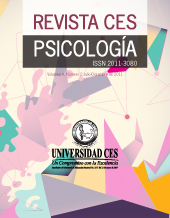Life Satisfaction in Chilean University Students: An Examination of the Relation between Gender and Socioeconomic Level
DOI:
https://doi.org/10.21615/cesp.11.1.4Palavras-chave:
Subjective Well-Being, Life Satisfaction, Multidimensional, University StudentsResumo
The objectives of this study were to examine the psychometric properties of the Multidimensional Life Satisfaction Scale in university students (MSLSS) (Huebner, 1998) in a sample of university students from northern, central and southern Chile, where indicators of reliability and construct validity were examined. Also, it seeks to describe the levels of life satisfaction of students and to examine differences between gender and between socioeconomic statuses. The study is quantitative with a cross-sectional descriptive-relational design. The Multidimensional Life Satisfaction Scale was applied to a sample of 306 university students in northern, central and southern Chile, as well as a questionnaire that collected sociodemographic variables. It was used confirmatory factor analysis to evaluate the model expected from the five factors of the 40-item version of the scale. The results showed the scale had adequate psychometric behavior in this type of population, where also high satisfaction levels in overall and specific domains were found, and group differences were found by gender but not by socioeconomic status.
Downloads
Referências
Abad, F., Garrido, J., Olea, J. & Ponsoda, V. (2006). Introducción a la Psicometría: teoría clásica de los test y teoría de la respuesta al ítem. España: Universidad Autónoma de Madrid.
Abad, F. J., Olea, J., Ponsoda, V. & García, C. (2011). Medición en ciencias sociales y de la salud. Madrid: Síntesis.
Adimark (2000). El nivel socioeconómico ESOMAR. Manual de aplicación. Santiago: Adimark.
Aguilar, Y., Valdez, J., González-Arratia, N. & González, S. (2013). Los roles de género de los hombres y las mujeres en el México contemporáneo. Enseñanza e investigación en psicología, 18(2), 207-224.
Arita, B. (2005). Satisfacción por la vida y teoría homeostática del bienestar. Psicología y Salud, 15(1), 121-126.
Barraza, C. & Ortiz, L. (2012). Factores relacionados a la calidad de vida y satisfacción en estudiantes de enfermería. Cienc. enferm, 18(3), 111-119. DOI: http://dx.doi.org/10.4067/S0717-95532012000300011
Brown, T. A. (2006). Confirmatory factor analysis for applied research. New York, NY: Guilford.
Chavarría, M. & Barra, E. (2014). Satisfacción Vital en Adolescentes: Relación con la Autoeficacia y el Apoyo Social Percibido. Ter Psicol, 32(1), 41-46. DOI: http://dx.doi.org/10.4067/S0718-48082014000100004
Cohen, J. (1988). Statistical Power Analysis for the Behavioral Sciences. Second Edition. Hills date, NJ: LEA.
Cronbach, L. J. (1951). Coefficient alpha and the internal structure of tests. Psychometrika, 16, 297-334. DOI: 10.1007/BF02310555
Denegri, M., García, C., González, N., Orellana, L., Sepúlveda, J. & Schnettler, B. (2014). Bienestar Subjetivo y Satisfacción con la Alimentación en estudiantes universitarios: Un estudio cualitativo. SUMMA psicológica UST, 11(1), 51-63.
Díaz, D., Rodríguez-Carvajal, R., Blanco, A., Moreno-Jimenez, B., Gallardo, I., Valle, C. & Van Dierendonck, D. (2006). Adaptación española de las escalas de bienestar psicológico de Ryff. Psicothema, 18(3), 572-577.
Díaz, R., Carús, M., Macossay, C., & Barbosa I. (2010). Efecto del estilo de vida en los hábitos y conductas alimentarias en universitarios. Revista Exploratoris, 1.
Diener, E., Emmons, R. A., Larsen, R. J., & Griffin, S. (1985). The satisfaction with life scale. Journal of Personality Assessment, 49, 71–75. DOI: 10.1207/s15327752jpa4901_13
Diener, E. (1994). El bienestar subjetivo. Intervención psicosocial. Revista sobre igualdad y calidad de vida, 3(8), 67-113.
Diener, E. & Diener, M. (1995). Cross-cultural correlates of life satisfaction and self-esteem. Journal of Personality and Social Psychology, 69, 120-129. DOI: 10.1037/0022-3514.68.4.65
Diener, E., Suh, E., Lucas, R., & Smith, H. (1999). Subjective well-being: three decades of progress. Psychological Bulletin, 125(2), 276-302. DOI: 10.1037/0033-2909.125.2.276
Diener, E. (2000). Subjective well-being: the science of happiness and proposal for national index. American Psychologist, 55, 34-43. DOI: http://dx.doi.org/10.1037/0003-066X.55.1.34
Domínguez-Espinoza, A., Salas, I., Contreras, C. & Procidano, M. (2011). Validez concurrente de la versión mexicana de las escalas de Apoyo Social Percibido de la Familia y los Amigos (PSS-Fa y PSS-Fr). Revista Latinoamericana de Psicología, 43(1), 125-137. DOI: http://dx.doi.org/10.14349/rlp.v43i1.622
Eid, M. & Diener, E. (2004).Global judgements of subjective well-being: Situational variability and long-term stability. Social Indicators Research, 65, 245-277. DOI: 10.1023/B:SOCI.0000003801.89195.bc
Florenzano, R. (2005). Salud mental y características de personalidad de los estudiantes universitarios en Chile. Revista Calidad de la Educación, 23, 103-114.
Galindez, E. & Casas, F. (2011). Adaptación y validación de la MSLSS de satisfacción vital multidimensional con una muestra de adolescentes. Revista de Psicología Social, 26(3), 309-323. DOI: 10.1174/021347411797361284
García-Viniegras, C. & González, I. (2000). La categoría bienestar psicológico. Su relación con otras categorías sociales. Rev Cubana Med Gen Integr., 16(6),586-92.
Gilman, R., Huebner, E. S. y Laughlin, J. (2000). A first study of the Multidimensional Students' Life Scale with adolescents. Social Indicators Research, 52, 135-160. DOI: 10.1023/A:1007059227507
Gilman, R., Easterbrooks, S. R. & Frey, M. (2004). A preliminary study of multidimensional life satisfaction among deaf/heard of hearing youth across environmental settings. Social Indicators Research, 66, 143-163. DOI: 10.1023/B:SOCI.0000007495.40790.85
Gomberoff, L. (2003). Hacia la construcción final de la personalidad durante la adolescencia. Algunas configuraciones psicopatológicas. Psiquiatría y Salud Mental, 19 (1), 22-35.
Gómez, V., Villegas, C., Barrera, F. & Cruz, J. (2007). Factores predictores de bienestar subjetivo en una muestra colombiana. Revista Latinoamericana de Psicología, 39(2), 311-325.
Greenspoon, P. J. y Saklofske, D. H. (1997). Validity and reliability of the Multidimensional Students’ Life Satisfaction Scale with Canadian children. Journal of Psychoeducational Assessment, 15, 138-155. DOI: 10.1177/073428299701500204
Greenspoon, P. J. y Saklofske, D. H. (1998). Confirmatory factor analysis of the multidimensional Student's Life Satisfaction Scale. Personality and Individual, 25, 965-971. DOI: 10.1016/S0191-8869(98)00115-9
Headey, B. & Wearing, A. (1992). Understanding happiness: A theory of subjective well-being. Melbourne: Longman.
Hernández, R., Fernández, C. & Baptista, P. (2006). Metodología de la investigación. México: McGraw-Hill.
Huebner, E. S. (1994). Preliminary development and validation of a multidimensional life satisfaction scale for children. Psychological Assessment, 6, 149-158. DOI: http://dx.doi.org/10.1037/1040-3590.6.2.149
Huebner, E. S., Laughlin, J. E., Ash, C. & Gilman, R. (1998). Development of a new measure of children’s psychological well-being: Further validation of the multidimensional Students’ Life Satisfaction Scale. Journal of Psychoeducational Assessment, 16, 118-134. DOI: 10.1177/073428299801600202
Huebner, E.S. (2001). Manual for the Multidimensional Student’s Life Satisfaction Scale. University of South Carolina.
Huebner, E. S. & Gilman, R. (2002). An introduction to the Multidimensional Students' Life Satisfaction Scale. Social Indicators Research, 60, 115-122. DOI: 10.1023/A:1021252812882
Inglehart, R (1990). Culture shift in advanced industrial society. New York: Princeton University Press.
Lance, C. E., Butts, M. M. & Michels, L. C. (2006). The sources of four commonly reported cutoff criteria: What did they really say? Organizational Research Methods, 9, 202–220. DOI: 10.1177/1094428105284919
Lane, R. (2000). The loss if happiness in the market democracies. Yale: Yale University Press.
Liberalesso, A. (2002) Bienestar subjetivo en la vida adulta y en la vejez: hacia una psicología positiva; en América Latina. Revista Latinoamericana de Psicología, 34(1-2), 55-74.
Marsh, H. W., Wen, Z. & Hau, K.-T. (2004). Structural equation models of latent interactions: Evaluation of alternative estimation strategies and indicator construction. Psychological Methods, 9, 275–300. DOI: 10.4256/mio.2010.0030
Martínez-Arias, R. (1995). Psicometría: teoría de los tests psicológicos y educativos. Madrid: Síntesis.
Martínez, L. (2007). Mirando al futuro: Desafíos y oportunidades para el desarrollo de los adolescentes en Chile. Psykhe, 16, 3-14. DOI: http://dx.doi.org/10.4067/S0718-22282007000100001
Martínez, P. (2004). Perspectiva temporal futura y satisfacción con la vida a lo largo del ciclo vital. Revista de Psicología de la PUCP, 22(2), 215-252.
Meda, R., De Santos, F., Lara, B., Verduro, J., Palomera, A. & Valadez, M. (2008). Evaluación de la percepción de calidad de vida y el estilo de vida en estudiantes desde el contexto de las Universidades Promotoras de la Salud. Revista de Educación y Desarrollo, 8, 5-16.
Micin, S. & Bagladi, V. (2011). Salud Mental en estudiantes universitarios: Incidencia de psicopatología y antecedentes de conducta suicida en población que acude a un Servicio de Salud Estudiantil. Terapia psicológica, 29(1), 53-64. DOI: http://dx.doi.org/10.4067/S0718-48082011000100006
Moyano, E., Cornejo, F., Carreño, M. & Muñoz, A. (2013). Bienestar Subjetivo en Maximizadores y Satisfacedores. Terapia psicológica, 31(3), 273-280. DOI: http://dx.doi.org/10.4067/S0718-48082013000300001
Muthén, L.K. & Muthén, B.O (1998-2012). Mplus User’s Guide (Version 7.). Los Angeles: Muthén & Muthén.
Muthén, L.K. & Muthén, B.O. (2007). MPLUS statistical analysis with latent variables. User’s Guide. Los Angeles, CA: Muthén and Muthén.
Muthén, L. K. & Muthén, B. O. (2010). Mplus user’s guide. Los Angeles: Muthén & Muthén.
Nunnally, J. C. (1967). Psychometric theory. Nueva York: McGraw.
Oyanedel, J. C., Alfaro, J. & Mella, C. (2015). Bienestar Subjetivo y Calidad de Vida en la Infancia en Chile. Revista Latinoamericana de Ciencias Sociales, Niñez y Juventud, 13(1), 313-327.
Páez, D., Bilbao, M. & Javaloy, F. (2008). Del trauma a la felicidad. En M. Casullo (2008) Prácticas en Psicología Positiva (pp. 159-202). Buenos aires: Lugar Editorial.
San Martin, J. & Barra, E. (2013).Autoestima, Apoyo Social y Satisfacción Vital en Adolescentes. Ter Psicol, 31(3), 287-291. DOI: http://dx.doi.org/10.4067/S0718-48082013000300003
Sawatzky, R., Ratner, P. A., Johnson, Joy. L., Kopec, J. A. & Zumbo, B. D. (2009). Sample heterogeneity and the measurement structure of the Multidimensional Students’ Life Satisfaction Scale. Social Indicator Research, 94, 273-96. DOI: 10.1007/s11205-008-9423-4
Schnettler, B., Miranda, H., Sepúlveda, J. & Denegri, M. (2011). Satisfacción con la alimentación y la vida, un estudio exploratorio en estudiantes de la Universidad de la Frontera, Temuco-Chile. Psicología & Sociedade, 23(2), 426-435. DOI: http://dx.doi.org/10.1590/S0102-71822011000200024
Schnettler, B., Denegri, M., Miranda, H., Sepúlveda, J., Orellana, L., Paiva, G. & Grunert, K. (2013). Hábitos alimentarios y bienestar subjetivo en estudiantes universitarios del sur de Chile. Nutr Hosp., 28(6), 2221-2228. DOI: http://dx.doi.org/10.3305/nh.2013.28.6.6751
Schnettler, B., Orellana, L., Sepúlveda, J., Miranda, H., Grunert, K. & Lobos, G. (2014). Propiedades psicométricas de la Escala de Satisfacción Multidimensional con la Vida en una muestra de estudiantes universitarios chilenos. Revista de Psicología Social (Artículo en revisión).
Schreiber, J.B., Stage, F.K., King, J., Nora, A. & Barlow, E.A. (2006). Reporting structural equation modeling and confirmatory factor analysis results: A review. Journal of Educational Research, 99:323–337. DOI: 10.3200/JOER.99.6.323-338
Seidlitz, L., Wyer, R. S. & Diener, E. (1997). Cognitive correlates of subjective well-being: The processing of valenced lifeevents by happy and unhappy persons. Journal of Research in Personality 31, 240-256. DOI: http://dx.doi.org/10.1006/jrpe.1997.2184
Vega-Robles, Isabel. (2007). Relaciones de equidad entre hombres y mujeres: Análisis crítico del entorno familiar. Actualidades en psicología, 21(108), 59-78. DOI: http://dx.doi.org/10.15517/ap.v21i108.30
Veenhoven, R. (1991). Is happiness relative? Social Indicators Research, 24, 1-34. DOI: 10.1007/BF00292648
Zegers, B., Rojas-Barahona, C. & Forster, C. (2009).Validez y Confiabilidad del índice de Satisfacción Vital (LSI-A) de Neugarten, Havighursty Tobin en una Muestra de Adultos y Adultos Mayores en Chile. Ter Psicol, 27 (1), 15-26. DOI: http://dx.doi.org/10.4067/S0718-48082009000100002
Zubieta, E. & Delfino, G. (2010). Satisfacción con la vida, bienestar psicológico y bienestar social en estudiantes universitarios de Buenos Aires. Anu. investig, 17, 277-283.
Zubieta, E., Muratori, M. & Fernández, O. (2012). Bienestar subjetivo y psicosocial: Explorando diferencias de género. Salud & Sociedad, 3(1), 66-76.
Downloads
Publicado
Como Citar
Edição
Seção
Licença
Copyright (c) 2017 Marianela Denegri Coria, Nicolle González Rivera

Este trabalho está licenciado sob uma licença Creative Commons Attribution-NonCommercial-ShareAlike 4.0 International License.
Revista CES Psicología ISSN 2011 3080
Facultad de Psicología, Universidad CES Primera edición 2008. Última actualización Mayo 18 de 2022. Todos los derechos reservados. Hecho el depósito legal que exige la ley.
Se autoriza la reproducción total o parcial de los artículos citando la fuente y el autor. This publication may be reproduced by mentioning the source and the authors.
| Métricas do artigo | |
|---|---|
| Vistas abstratas | |
| Visualizações da cozinha | |
| Visualizações de PDF | |
| Visualizações em HTML | |
| Outras visualizações | |




